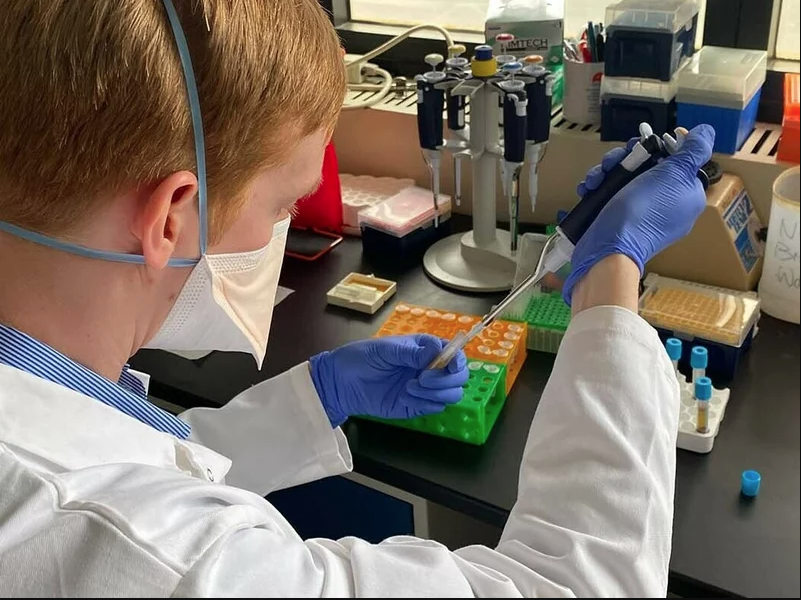The Ongoing Puzzle of Long COVID
Blood Biomarkers Found Long COVID—also known as Post-Acute Sequelae of SARS-CoV-2 infection (PASC)—continues to be a major global health concern, even years after the initial pandemic wave. Characterized by symptoms such as chronic fatigue, brain fog, shortness of breath, and muscle pain, Long COVID affects millions of people long after their acute infection has resolved.
In a major medical update for 2025, scientists have uncovered specific blood biomarkers linked to Long COVID symptoms. These findings could revolutionize how we diagnose, monitor, and eventually treat this debilitating condition.
This article explores the latest research, the key biomarkers identified, how this development could lead to a blood test for Long COVID, and what it means for patients worldwide.

What Are Blood Biomarkers and Why Do They Matter?
long COVID blood biomarkers, inflammation markers in long COVID
Biomarkers are biological indicators—usually found in blood, saliva, or tissues—that signal a physiological or pathological process. In the context of Long COVID, identifying biomarkers is crucial because:
- It provides a biological explanation for lingering symptoms.
- It enables early diagnosis and objective tracking.
- It may point toward targeted treatment options.
Until now, Long COVID has been largely diagnosed based on symptoms alone, which can vary widely and be difficult to validate. With biomarkers, we now have hard scientific evidence.
The 2025 Breakthrough: What the Latest Studies Reveal
latest long COVID research, biomarkers linked to long COVID
In early 2025, a collaborative study between Harvard Medical School, the NIH, and several European research centers identified a set of 10 blood biomarkers strongly associated with Long COVID.
🧪 Key Findings:
- Elevated IL-6 and IL-1β – Indicators of chronic inflammation and immune dysregulation.
- Increased levels of CXCL10 – A chemokine involved in immune cell recruitment, linked with fatigue and brain fog.
- Altered ACE2 activity – The receptor used by SARS-CoV-2 to enter cells, found at abnormal levels in Long COVID patients.
- Presence of specific autoantibodies – Suggesting an autoimmune component.
- Persistent viral fragments (S1 spike protein) – Found in plasma months after infection.
🔬 What This Means
These biomarkers can potentially distinguish Long COVID sufferers from both healthy individuals and recovered COVID patients. This could lead to accurate diagnostic tests, and provide clues to treatment pathways by targeting inflammation, viral persistence, or autoimmunity.
Blood Test for Long COVID: Coming Soon?
blood test for long COVID, Long COVID diagnosis 2025, persistent COVID symptoms test
Thanks to these new findings, commercial and academic labs are racing to develop a reliable blood test for Long COVID. Two tests are currently in advanced development:
1. BiomarkDx Long COVID Panel
- A multi-marker blood test targeting IL-6, CXCL10, ACE2, and autoantibodies.
- Undergoing clinical validation in the U.S. and U.K.
- Expected launch: Q4 2025.
2. PASC-Scan by ImmunoTrace
- Focuses on inflammatory proteins and viral persistence.
- Designed for hospital use and long-term care providers.
These diagnostic tools could be game-changers for both clinicians and patients—providing objective data and helping to prioritize treatment.
Symptoms Linked to Identified Biomarkers
long COVID symptoms 2025, COVID fatigue biomarker
Researchers found that specific symptoms correspond closely with certain biomarkers. This opens up the possibility for personalized medicine approaches.
| Symptom | Associated Biomarker(s) |
|---|---|
| Fatigue | CXCL10, IL-6 |
| Brain Fog | CXCL10, IL-1β |
| Muscle Pain | Autoantibodies, IL-6 |
| Shortness of Breath | ACE2, IL-6 |
| Anxiety/Depression | Altered serotonin signaling (under study) |
By matching biomarkers to symptoms, doctors may be able to tailor treatments more effectively.

Inflammation and the Immune System: A Central Role
immune system and long COVID, inflammation markers in long COVID
One of the most consistent findings across studies is that chronic inflammation and immune dysregulation are major drivers of Long COVID.
- IL-6 and IL-1β levels remain elevated in many patients.
- T-cell exhaustion is observed, reducing the body’s ability to clear remaining viral fragments.
- Persistent low-grade inflammation damages tissues over time—particularly the nervous system, muscles, and lungs.
These discoveries highlight the importance of anti-inflammatory and immunomodulatory therapies, some of which are already being trialed.
Treatment Implications: The Road Ahead
treatment for long COVID 2025, targeted therapies for long COVID
The identification of these biomarkers is not just diagnostic—it’s also therapeutic.
🔍 Ongoing Clinical Trials (2025)
- Low-dose IL-6 inhibitors – Repurposed from rheumatoid arthritis drugs.
- Plasma filtration therapy – Aims to remove autoantibodies.
- Antiviral therapies – Designed to eliminate persistent spike proteins.
- Personalized immunotherapy – Targeting specific cytokine imbalances.
As of May 2025, more than 50 clinical trials worldwide are investigating treatments directly informed by the biomarker data.
Real Patient Impact: Stories Behind the Science
Long COVID diagnosis 2025, persistent COVID symptoms
Case 1: Sarah, 35 – Diagnosed With Long COVID via Biomarker Panel
Sarah had COVID-19 in 2021 and never fully recovered. Despite normal imaging, she experienced crushing fatigue and mental fog. In 2025, she took part in a biomarker trial that confirmed elevated CXCL10 and IL-6—validating her condition and guiding treatment.
“It was the first time someone told me I wasn’t crazy. That test changed everything.”
Case 2: Marcus, 52 – Inflammatory Markers Drive Targeted Treatment
A retired firefighter, Marcus suffered from chest pain and breathlessness after COVID. A biomarker test revealed elevated ACE2 and autoantibodies. He was enrolled in a clinical trial using immunotherapy, and now reports 60% symptom improvement.
These examples show how real people are benefiting from this emerging science.
How to Access Testing and Research Opportunities
how to get tested for long COVID, long COVID clinical trials 2025
If you believe you may have Long COVID, here are actionable steps:
- Talk to your doctor about new testing options.
- Enroll in a clinical study – Visit clinicaltrials.gov and search for “Long COVID biomarker”.
- Monitor your symptoms – Keep a detailed journal to aid diagnosis.
- Request blood work for inflammatory markers if you’re symptomatic.
As tests become more widely available, accessibility and affordability are expected to improve.
Key Takeaways: Why This Matters
🔹 For Patients:
- You’re not imagining your symptoms—biomarkers prove Long COVID is real.
- New blood tests could lead to earlier and more accurate diagnosis.
- Targeted treatments are on the horizon.
🔹 For Clinicians:
- Better tools for diagnosing and managing patients.
- Opportunities to personalize treatment.
- Stronger framework for validating patient symptoms.
🔹 For Public Health:
- A path toward standardizing Long COVID diagnosis.
- Improved ability to track population-level impact.
- Informing policy, disability access, and healthcare coverage.
What Are Biomarkers and How Are They Used in Diagnosing Illnesses?
Keyword focus: biomarkers for post-COVID syndrome, medical test for long COVID
Biomarkers are measurable indicators of biological states or conditions—like proteins, enzymes, hormones, or immune cells—found in bodily fluids such as blood or saliva.
They’re already widely used in diagnosing:
- Diabetes (via blood sugar levels)
- Heart attacks (via troponin levels)
- Infections (via white blood cell counts)
In the case of Long COVID, biomarkers can offer concrete proof of underlying physiological changes caused by the virus or immune response.
A New Chapter in Long COVID Research
The identification of blood biomarkers linked to Long COVID symptoms is one of the most promising developments in post-pandemic medical research. As we move further into 2025, these discoveries could finally provide clarity, validation, and hope to those living with this invisible illness.
For the first time, we are on the brink of a biological test that confirms what millions already know: Long COVID is real, measurable, and treatable.
New Research: The First Set of Validated Biomarkers for Long COVID (2025)
Keyword focus: latest COVID-19 research 2025, long COVID immune response
In 2025, multiple peer-reviewed studies—most notably from Stanford University, University College London, and the NIH Long COVID Consortium—uncovered a group of blood-based indicators that correlate strongly with persistent post-COVID symptoms.
🔬 The 5 Most Significant Biomarkers Identified:
| Biomarker | Role in the Body | Long COVID Relevance |
|---|---|---|
| IL-6 | Inflammatory cytokine | Linked with fatigue, mood disorders |
| CXCL10 | Immune signaling protein | Associated with brain fog |
| TNF-alpha | Inflammatory regulator | Correlated with muscle aches, malaise |
| Autoantibodies (ANA, antinuclear) | Immune dysregulation | Suggest autoimmune involvement |
| Circulating Spike Protein Fragments | Viral remnants | Implicates viral persistence |
How the New Long COVID Blood Tests Work
These blood tests operate similarly to other diagnostic panels:
- A small blood sample is drawn and analyzed in a laboratory.
- Multiple biomarkers are measured at once using immunoassays or mass spectrometry.
- The test produces a composite “risk score” or pattern profile that helps doctors distinguish Long COVID from depression, chronic fatigue syndrome (CFS/ME), or anxiety.
🧪 Key Tests Under Development:
- ImmuneMap™ Long COVID Panel
- Measures IL-6, TNF-alpha, and viral fragments
- Designed for hospital and research clinics
- VeriLong™ Diagnostic Test
- Commercial test aimed at general practitioners
- FDA fast-track approval status as of April 2025
Who Should Get Tested? Symptoms That May Indicate Long COVID
Not everyone with COVID-19 experiences long-term effects—but those who do often report symptoms that are multi-systemic and not explained by standard tests.
⚠️ Common Long COVID Symptoms:
- Chronic fatigue or exhaustion
- Cognitive difficulties (“brain fog”)
- Sleep disturbances
- Shortness of breath or chest tightness
- Muscle and joint pain
- Post-exertional malaise
- Anxiety or depression
- Heart palpitations
If these symptoms persist beyond 3 months post-infection, a biomarker-based test may confirm a Long COVID diagnosis.
Why This Discovery Matters for Patients
One of the most damaging aspects of Long COVID is the stigma and disbelief many patients face. With no clear biological proof, many were misdiagnosed or dismissed.
This breakthrough provides:
- Scientific validation of patients’ lived experiences
- A tool for doctors to diagnose and monitor progress
- A framework for insurance and disability coverage
- A foundation for personalized treatment plans
Patients are finally able to say, “There’s a test. There’s evidence. This is real.”
The Science of Immune Dysfunction in Long COVID
At the heart of this research is the immune system’s overreaction or failure to “turn off” after the virus is cleared. Scientists have discovered:
- Persistent activation of innate immune cells (like monocytes and macrophages)
- T-cell exhaustion, reducing adaptive immune memory
- Autoantibody formation, suggesting immune confusion
- Ongoing endothelial inflammation, damaging blood vessels
These phenomena may explain why Long COVID mimics autoimmune or neuro-inflammatory diseases.
Current and Future Treatments Based on These Biomarkers
Keyword focus: targeted treatments for long COVID, long COVID therapy 2025
The identification of biomarkers paves the way for targeted medical therapies.
🧬 Promising Treatments Being Trialed:
- Low-dose corticosteroids – for inflammation control
- IL-6 inhibitors – already used in rheumatoid arthritis
- Antiviral drugs – for patients with spike protein remnants
- Immune modulators – including LDN (low-dose naltrexone)
- Monoclonal antibodies – targeting specific immune reactions
Clinical trials are now being matched to patient biomarker profiles, ushering in precision medicine for Long COVID.
Frequently Asked Questions (FAQs)
❓ Is this blood test available now?
Not yet commercially widespread, but pilot programs and trials are ongoing in the U.S., U.K., Germany, and Australia. A full launch is expected by early 2026.
❓ Can it be used to predict Long COVID before symptoms start?
Researchers are studying pre-illness biomarker levels to determine risk factors, but prediction remains in early stages.
❓ Will insurance cover this test?
Coverage is likely once the test receives FDA or national health authority approval and becomes a standard of care.
Public Health Implications: Beyond the Individual
Keyword focus: long COVID testing programs, population-level COVID diagnostics
Widespread biomarker testing could:
- Help quantify true Long COVID prevalence
- Allow early intervention and reduce long-term disability
- Support resource planning in healthcare systems
- Provide legal backing for employment and benefits claims
In countries with universal healthcare, the test may be integrated into post-COVID care pathways.
Global Research Collaborations Driving the Science Forward
Institutions involved in major Long COVID biomarker research:
- National Institutes of Health (NIH) – U.S.
- King’s College London – U.K.
- Charité – Universitätsmedizin Berlin – Germany
- University of Melbourne – Australia
- World Health Organization (WHO) – Global coordination
Together, they are building a shared global database of Long COVID patient profiles and immune markers.
Toward a Future Where Long COVID Is Measurable and Treatable
This 2025 breakthrough offers hope and validation to millions still suffering from the lingering effects of COVID-19. With blood biomarkers now identified, the future holds:
- Reliable diagnostics
- Targeted therapies
- Better patient care
- Recognition of a misunderstood illness
As research progresses, what was once called “medically unexplained” is now scientifically defined—and that’s the first step toward healing.


